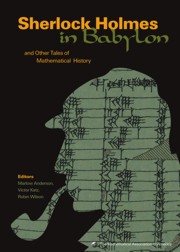Book contents
- Frontmatter
- Introduction
- Contents
- Ancient Mathematics
- Foreword
- Sherlock Holmes in Babylon
- Words and Pictures: New Light on Plimpton 322
- Mathematics, 600 B.C.–600 A.D.
- Diophantus of Alexandria
- Hypatia of Alexandria
- Hypatia and Her Mathematics
- The Evolution of Mathematics in Ancient China
- Liu Hui and the First Golden Age of Chinese Mathematics
- Number Systems of the North American Indians
- The Number System of the Mayas
- Before The Conquest
- Afterword
- Medieval and Renaissance Mathematics
- The Seventeenth Century
- The Eighteenth Century
- Index
- About the Editors
Number Systems of the North American Indians
from Ancient Mathematics
- Frontmatter
- Introduction
- Contents
- Ancient Mathematics
- Foreword
- Sherlock Holmes in Babylon
- Words and Pictures: New Light on Plimpton 322
- Mathematics, 600 B.C.–600 A.D.
- Diophantus of Alexandria
- Hypatia of Alexandria
- Hypatia and Her Mathematics
- The Evolution of Mathematics in Ancient China
- Liu Hui and the First Golden Age of Chinese Mathematics
- Number Systems of the North American Indians
- The Number System of the Mayas
- Before The Conquest
- Afterword
- Medieval and Renaissance Mathematics
- The Seventeenth Century
- The Eighteenth Century
- Index
- About the Editors
Summary
The linguistic diversity of the Indians inhabiting the North American continent is one of the most remarkable features of world ethnology. The late director of the Bureau of American Ethnology says: “In philology, North America presents the richest field in the world, for here is found the greatest number of languages distributed among the greatest number of stocks.[16, p. 78] The Bureau recognizes almost three score distinct linguistic families having no lexical resemblance, no apparent unity of origin, no relation to European or Asiatic languages. These “families” are further subdivided linguistically into 750 “tribes” or languages. [17, p. 1]
These languages differ as widely in number words and number systems as they do in other features. This is in marked contrast with the languages of the great Indo-European family where, even in languages which are mutually unintelligible, the same root words appear with great uniformity in the numerals. The very remarkable differences in the form and use of the numerals of the American Indians afford a fruitful field for study of the evolution of the concept of number among hundreds of distinct, uncivilized peoples. This paper is based upon an examination of the number systems of more than three hundred of these languages in North America. We will discuss the origin of number words and their principles of formation, the way in which they were built up into number systems, and some of the variations of these systems in actual use.
- Type
- Chapter
- Information
- Sherlock Holmes in BabylonAnd Other Tales of Mathematical History, pp. 83 - 93Publisher: Mathematical Association of AmericaPrint publication year: 2003



